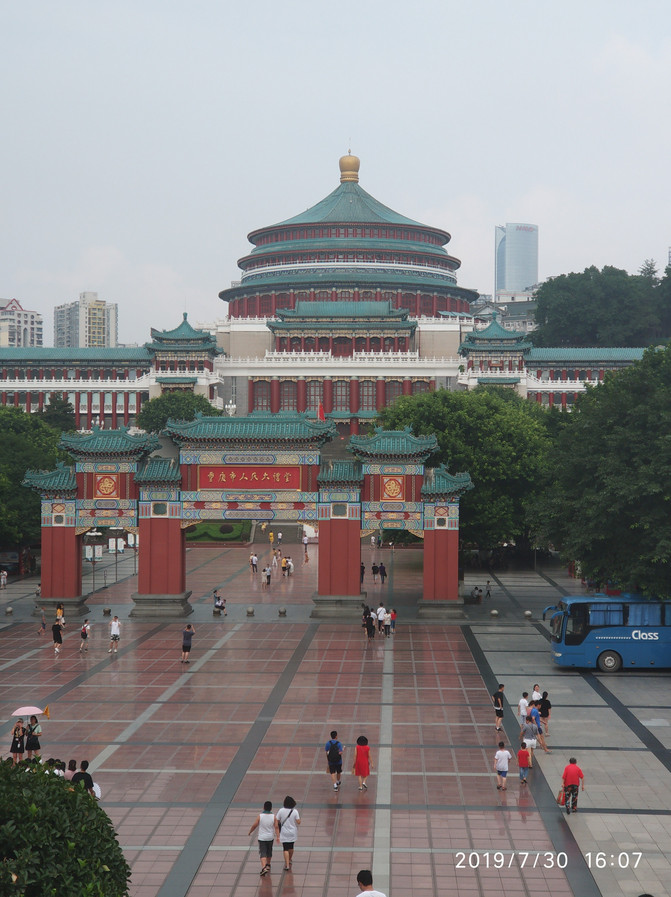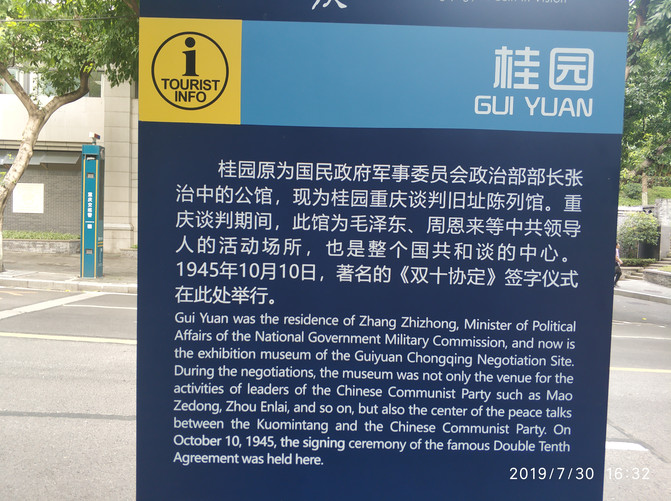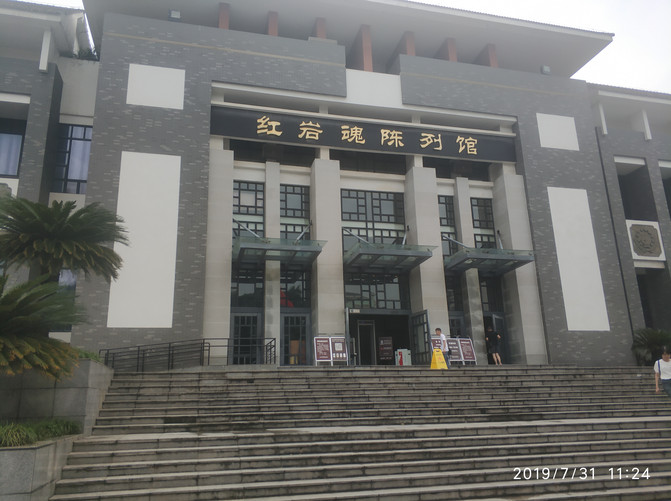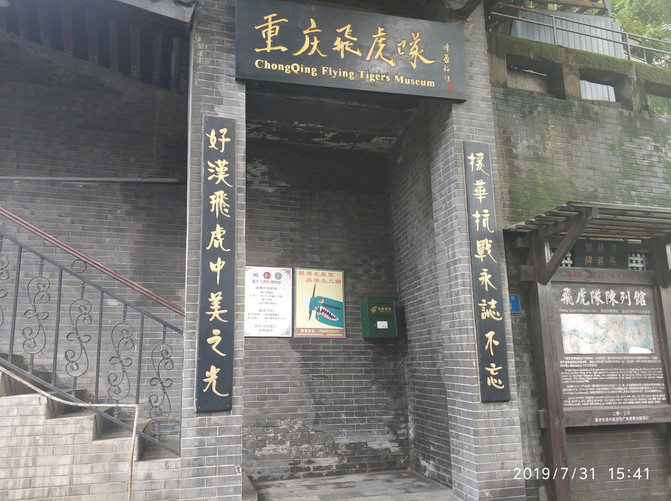Strolling through the mountainous city of Chongqing
Chongqing deserves the title of "Mountain City". When you come here, you will find that encountering a large piece of flat land is a rare thing. Most of the buildings here are built on slopes of varying degrees, and it is common to see only a short distance between buildings here. I am not accustomed to taking many wrong paths in Chongqing. So, try to take a car as much as possible.
Eating: Food is mainly concentrated in Monument to the people's Liberation Delicious Street and Hongya Cave. Chongqing is most famous for hot pot, so I had a meal of Chongqing hot pot in Banzhongshan Hot Pot City.
Accommodation: I suggest living near Xiaoshizi. There are many express hotels and youth apartments here, and the transportation is convenient. It's not far from Monument to the people's Liberation on foot.
Okay: Chongqing's rail transit is very convenient, and it's best to choose rail transit for travel
Tour: In fact, there are many famous scenic spots around Chongqing, such as Dazu Rock Carvings, Wulong Tiankeng and Dijie, but it takes a lot of time on the road. I stayed in Chongqing for a short period of time and focused on visiting the main attractions in the city, such as the Three Gorges Museum, the Great Hall of the People, Hongyadong, and Ciqikou Ancient Town.
At noon, take the train to Chongqing, arrange accommodation in the center of Huayu North City in the south square of Chongqing Railway Station, take the subway to Zengjiayan Metro Station to visit the Three Gorges Museum, the Great Hall of the People, Zhou Mansion and Guiyuan Garden, and then take the bus to Monument to the people's Liberation, Hongya Cave and Yangtze River Cableway
Chongqing Three Gorges Museum The Chongqing China Three Gorges Museum is located on the central axis of the Chongqing People's Grand Hall. The underground level 1 is used for cultural relics storage, garage, and equipment rooms, while the above ground levels 4 are used for exhibition halls, lecture halls, and management auxiliary rooms. Among the numerous collections, unearthed cultural relics are well-known for their Ba Shu cultural relics, Sichuan Han painting bricks, portraits, stone pottery figurines, and relics from the Ming Yuzhen Ruiling Mausoleum, the founding emperor of the Yuan Dynasty and the Great Xia Dynasty. Among the handed down cultural relics, there are relatively systematic collections of calligraphy and painting by famous artists since the Song Dynasty, porcelain from famous kilns throughout history, purple clay from the Ming and Qing dynasties, coins from various dynasties, steles and stickers from various generations, jade artifacts, bamboo, wood, dental and bone utensils, silk, and cultural relics from southwestern ethnic groups.





The Chongqing Bombing Half Scene Painting Exhibition Hall "- formed through modern technological means, sculptures, oil paintings, and other comprehensive works, reflects the historical events of the Chongqing Bombing, allowing the audience to" personally "experience the tragedy of the bombing site, reproduce the tragedy and brutality of Chongqing, as a wartime capital, being bombed by Japanese planes for several years during the Anti Japanese War, and awaken people's love for peace and life.

People's Great Hall Built in June 1951 and completed in April 1954, Comrade He Long personally inscribed the name "Southwest Administrative Committee Grand Hall". The Great Hall is an antique ethnic architectural complex, one of the top ten cultural symbols in Chongqing, and also one of the unique landmark buildings in Chongqing. At the beginning of the founding of the People's Republic of China, in order to express the confidence of the newly established people's government in leading the people towards a brilliant future, and to trigger the climax of "building the Southwest", as well as to solve the practical problems of meetings and receptions, the main leaders of the Southwest Military and Political Committee, Deng Xiaoping, He Long, and Liu Bocheng, resolutely decided to build a new auditorium on Ma'anshan opposite the office building of the Southwest Military and Political Committee, which could accommodate four to five thousand people, and attach a guesthouse.

Residence of Mr. Zhou



Dai Li Mansion is not open

longan It is an independent courtyard with a street facing entrance. In 1939, Zhang Zhizhong was appointed as the Director (in charge of military affairs) of the Attendant Office of the Chairman of the Military Commission of the National Government. When he moved in, Zhang Zhizhong personally planted osmanthus trees and named this small courtyard "Guiyuan" after his father's name "Guihui". In August 1945, during the negotiations in Chongqing, Zhang Zhizhongdi prepared this place as a place for Mao Zedong to work and receive guests in Chongqing. Guiyuan was the place where Mao Zedong and Zhou Enlai, representing the Communist Party, negotiated and signed the "Minutes of the Talks between the Representatives of the Kuomintang and the Communist Party" (also known as the Double Tenth Agreement) with representatives of the Kuomintang. During the 43 day negotiation period between Mao Zedong and Chiang Kai shek from August to October 1945, Mao Zedong and Zhou Enlai met with various political parties and people from all walks of life here multiple times. On the afternoon of October 10, 1945, the Kuomintang and the Communist Party signed the famous "Double Tenth Agreement" in Guiyuan. Guiyuan has become an important witness to the negotiations between the Kuomintang and the Communist Party.




Take the subway from Zengjiayan Subway Station to the landmark building of Chongqing - Monument to the people's Liberation

Walk slowly from Monument to the people's Liberation to Arhat Temple
Arhat Temple : Ancient temples and famous temples are mostly hidden in remote mountains and forests, such as Baoguo Temple in Mount Emei, Bodhisattva Peak in Mount Wutai, Shaolin Temple in Mount Song, Hanging Temple in Mount Hengshan..., while Arhat Temple is located in downtown area. The "Arhat Temple" got its name in the 11th year of the reign of Emperor Guangxu in the Qing Dynasty (1885). At that time, the abbot Longfa built 500 Arhats Hall in the temple in the form of the Arhats Hall in Baoguang Temple, Xindu, Sichuan. From this, the name of Arhat Temple became better and better.



Walk from the Arhat Temple to the ticket office of the Yangtze River Cableway. The Yangtze River Cableway used to be a means of transportation across the river. Due to the shooting of several movies here and the promotion of online videos, it is now a must visit project for tourists in the mountain city. Chongqing is located at the intersection of two rivers. The city is in the mountains, the mountains are in the water, and the mountains are in the mountains. It is both a "river city" and a "mountain city", and it is more amazing to be a "city that never sleeps". The Yangtze River Cableway Scenic Area has concentrated the essence of "River City, Mountain City, and Night City". I walked to the Yangtze River Cableway and bought my ticket. There were many tourists, and the big screen showed that I had to wait for another 2 hours for my ticket number. Use this time to go to Hongyadong.
Hongya Cave Combining urban tourism landscape, business and leisure landscape, and urban cultural landscape. Based on the traditional architectural features of Ba Yu, the "stilted house" style is the main feature, built along the river in accordance with the mountain terrain. The six major business formats of catering, entertainment, leisure, health care, hotels, and characteristic cultural shopping are organically integrated to form a unique "three-dimensional aerial pedestrian street", becoming the most hierarchical and textured commercial center of urban scenic spots.




After strolling through Hongya Cave, walk to the Yangtze River Cableway to experience it






Rest for one night, the next day at Zhazidong, Baigongguan, Hongyan Pavilion, Ciqikou Ancient Town, Feihu Team Memorial Hall, Liziba, etc
The next morning, I took a bus to Zhazidong. Due to the rain, Zhazidong was temporarily closed to the public for cable maintenance
Zhazidong: Zhazidong was originally a small coal mine in the outskirts of Chongqing, named after its abundant slag and scarce coal. Zhazi Cave is surrounded by mountains on three sides and a ditch on one side, and its location is relatively hidden. In 1939, Kuomintang military intelligence agents forced the death of the mine owner, occupied the coal mine, and established a prison here. It is divided into two chambers: the inner and outer chambers. The outer chamber is used as a special agent's office and a torture room. The inner chamber has 16 rooms on the first floor and bottom for men's prisons, and two bungalows for women's prisons.

Walking from Zhazidong to Baigongguan, there are sculptures of martyrs and plum gardens along the way

Plum Garden In the spring of 1945, Dai Li, the director of the Sino US Institute of Special Technical Cooperation, built a villa in Zhongjiashan to welcome American representatives. He was the deputy director of the Sino US Institute of Special Technical Cooperation and Rear Admiral of the United States Navy, Meiles. Most of the building materials for the villa are air freighted from the United States. In the same summer, the villa was completed. Due to Meiles' love for plum blossoms, he took his Chinese name Meidongsheng. Dai Li named this villa "Meiyuan" and planted plum blossoms all around the villa.

Bai's residence Originally a suburban villa owned by Sichuan warlord Bai Ju. Bai Ju claimed to be a descendant of Bai Juyi, so he borrowed Bai Juyi's nickname "Xiangshan Jushi" and named his villa "Xiangshan Villa". In 1939, Dai Li took a liking to it when selecting a location under Geleshan Mountain, and bought it with a large sum of money to transform it into a prison for persecuting revolutionaries. It is also known as the "Two Living Coffins" along with Zhazidong. But they are also different. The political prisoners detained in Bai Mansion are all considered "serious cases" by the Military Statistics Bureau.







From Bai Mansion, you can walk or take the bus to the Red Rock Soul Exhibition Hall


Ciqikou Ancient Town, this is completely filled with snack shops, seasoning shops, etc., where else can you tell what kind of ancient town it looks like!






Coming out of Ciqikou Ancient Town, take a bus to Liziba Subway Station, which is a popular check-in spot for internet celebrities. The highlight is that the light rail seems to pass through high-rise buildings.


Visited the Flying Tigers Memorial Hall and General Stilwell's former residence near Liziba Station. Return to Liziba Light Rail Station and take a bus back to your residence.
General Stilwell's former residence was originally the Song Ziwen Palace, and from 1942 to 1944, General Stilwell, the Chief of Staff of the Allied Chinese Theater Command, resided there. The basement floor of the official residence was where the accompanying personnel lived and stored their weapons at that time. This has become several exhibition halls. More than 200 precious historical photos, arranged in chronological order, show us six aspects of the relationship between General Stilwell and China: "Stilwell and China," "Conquering India and Burma," "Flying Tiger Air Force," "Hump Flight," "US Army Observation Group in Yan'an," and "Friendship Endures." They document the inseparable bond between General Stilwell and China. Here, we not only saw General Stilwell's brilliant deeds in helping the Chinese government and people to jointly fight against Japanese fascist aggression, but also saw that he had conflicts with Chiang Kai shek because he advocated parallel assistance to the Kuomintang and the Communist forces, and also saw that he highly appreciated the CPC, which considered the overall situation and actively fought against Japan.







In the evening, I had a so-called Chongqing hotpot, but because I couldn't eat spicy food, I ordered a non spicy mushroom pot. I couldn't taste the representative flavor of Chongqing hotpot, so I went online to choose a popular hotpot restaurant - Banchongshan Hotpot City. I waited alone for more than 50 minutes, and because I was waiting for a seat, the restaurant offered me a 10 minute can of Jiaduobao beverage. When I was called in, the restaurant gave me 5 cans of beverage at once. I was also puzzled that I could give away one can of beverage alone. They explained that based on the waiting time, the beverage would be used as compensation.

I would also like to ask the waiter to help me bring it to the dining table. The waiter noticed that I was dining alone and placed a big teddy bear on the seat opposite me. I couldn't eat alone, it was so interesting.
